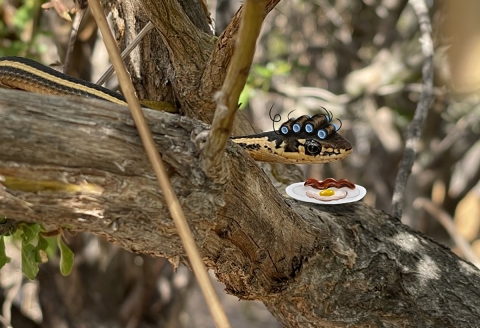Who wants to get out of bed when it’s cold outside? Certainly not these critters! They straight up sleep through the winter cold and won’t leave their cozy homes until the warmth of spring comes. Relatable. With spring weather sprouting across North America, we thought we’d check in with some of these hibernating experts as they're waking up from their lengthy slumber.
Alameda whipsnake
Okay, the Alameda whipsnake doesn’t sleep with curlers or even have hair. It does, however, take a long snooze in a hibernaculum, which is kind of an epic name for an underground retreat used by the snake for overwintering. The snake finds its cozy bed in November, and though it might stir a little over the winter, it stays there until March. Rather than bacon and eggs, the snake will look for small vertebrate prey after it wakes up, such as lizards and frogs. Soon after waking, an Alameda whipsnake male will start looking for a mate and travel around searching for females. Females tend to stay close to their hibernacula until it’s time for them to lay eggs. This species is listed as threatened, and you can help them by watching out for snakes basking in the road on sunny days!
Yosemite toad
Up in the mountains where Yosemite toads live, spring comes late and winter comes early, which means these toads sleep a long time in abandoned rodent burrows. Toads living in high elevations (up to 12,000 feet in elevation) spend more than half their lives in underground burrows. Depending on the weather, they can wake up any time from April to July to start doing their toad things — like eating bugs, finding a mate and laying eggs. We’ve helped them out by building wildlife road crossings so they can get where they need to go safely in the time they’re awake. Once they’ve reproduced, Yosemite toads then hike back to their burrows and hunker down for another winter in September or October. Maybe it’s the amount of beauty sleep they get but Yosemite toads have a long lifespan — up to 15 years!
Blunt-nosed leopard lizard
Yes, lizards also don’t have hair, but maybe they should! Blunt-nosed leopard lizards also take a long winter nap — a type of reptilian hibernation called brumation. Adults are active beginning in March or April and mate early, so a new generation of young lizards join the population in early summer. Adults tend to return to hibernation when the days are long and incredibly hot in the California desert sun. They return to their underground burrows as early as June and hibernate by fall. But the summer’s hatchlings will stay active longer and won’t retreat into rodent burrows for their winter sleep until mid-October or November. Learn more about the endangered blunt-nosed leopard lizard and how we’re working with partners to recover it.








